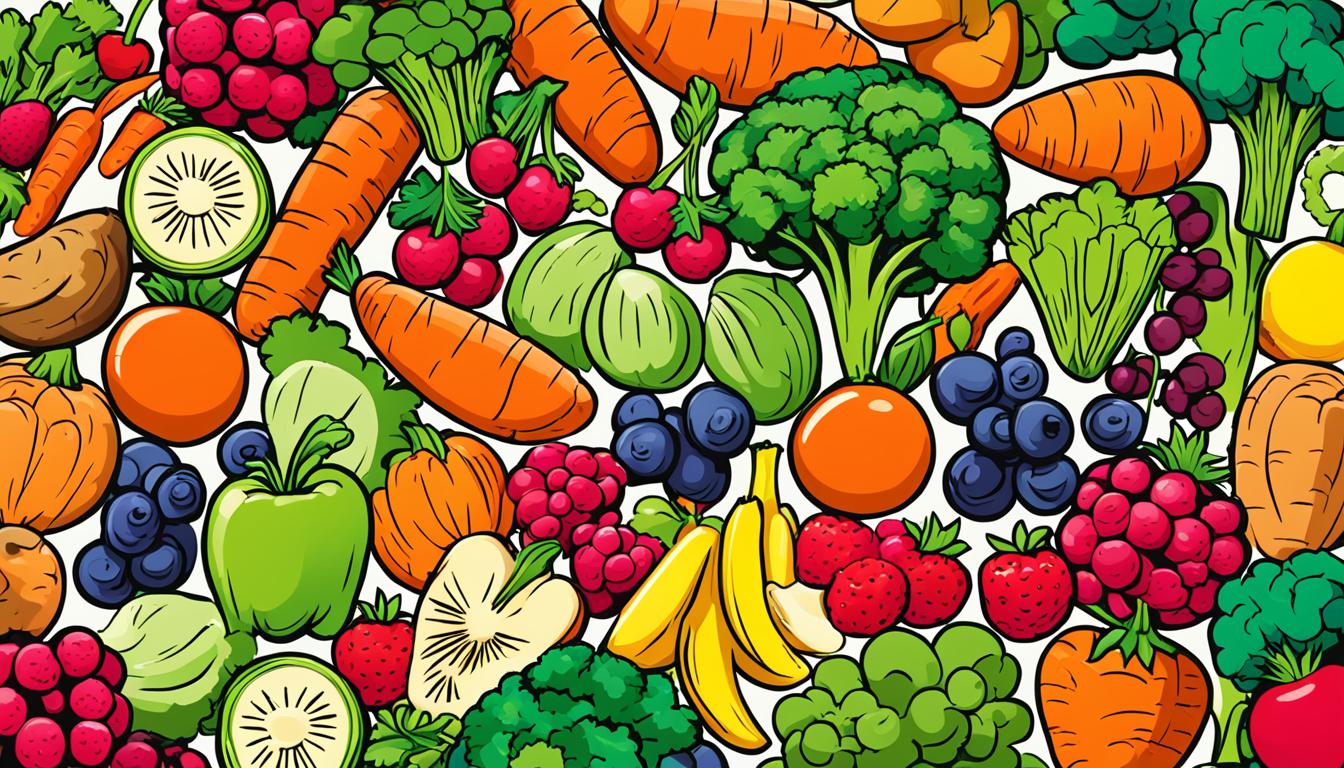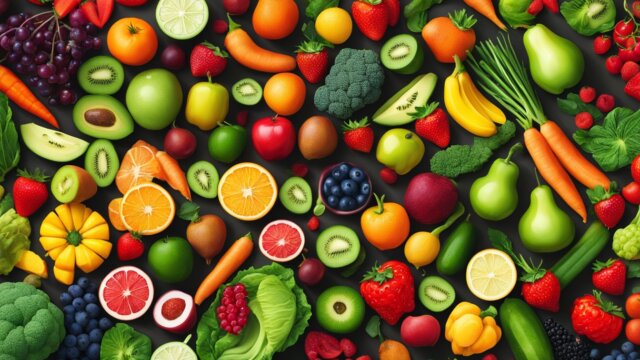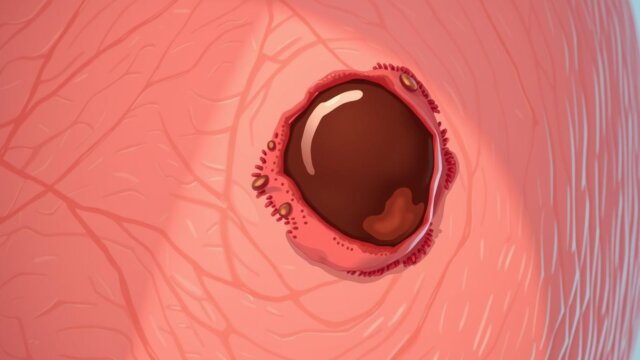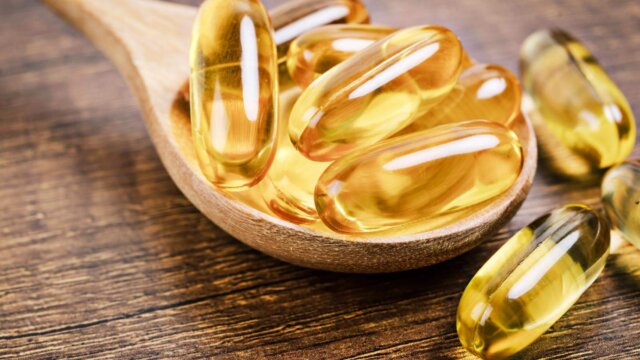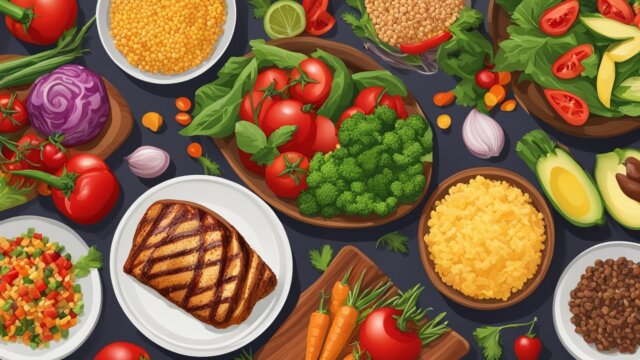FTC disclaimer: This post may contains affiliate links and we will be compensated if you click on a link and make a purchase.
Did you know that nearly all Americans lack enough fiber? This info is quite shocking and shows many don’t eat well. “Roughage” or “bulk” is key for staying healthy, especially for your gut.
Adding more fiber to your diet can enhance good gut bugs in just five days. But, most of us eat only half the fiber we need every day. This is a big deal because the tiny beings in your gut help keep you at a good weight.
Thankfully, eating high-fiber foods can do wonders for your stomach. They help with poop, lower bad cholesterol, and keep blood sugar in check. Let’s look at high-fiber foods and see how you can eat more for a happy gut.
Key Takeaways
- Fiber is an essential nutrient that plays a crucial role in maintaining a healthy digestive system.
- Most Americans fall short of the recommended daily fiber intake, which can have negative impacts on gut health and weight management.
- Incorporating high-fiber foods like whole grains, fruits, vegetables, legumes, nuts, and seeds can provide a wealth of benefits for your overall well-being.
- Increasing fiber intake can improve gut bacteria and promote regular bowel movements, cholesterol management, and blood sugar regulation.
- A variety of delicious and nutrient-dense high-fiber foods are available to help you boost your fiber consumption.
What is Dietary Fiber?
Dietary fiber is a part of plants that the body cannot break down. It keeps our digestion healthy. It doesn’t give us any nutrients but does a lot of good things as it moves through our bodies.
Soluble vs Insoluble Fiber
There are two types of fiber: soluble and insoluble. Soluble fiber mixes with water to form a gel. This can help lower our blood’s cholesterol and sugar. Insoluble fiber adds bulk to our stool and helps it pass through easily. It’s great for fighting constipation.
Eating lots of fiber foods like whole grains, fruits, and veggies is key for good health.
“Fiber works best when it absorbs water, making stool soft and bulky.”
Adding many fiber-rich foods to your meals helps your digestion and fights diseases.
Benefits of a High-Fiber Diet
Eating more foods rich in fiber brings many health boons. For instance, it keeps your bowel movements regular and your bowels healthy. Fiber can lower bad cholesterol, help control blood sugar, and manage weight. Also, research shows a link between eating more fiber, especially from cereals, and a lower risk of heart disease and cancer.
Meals with lots of fiber make you feel full longer and satisfied, cutting down on how much you eat and helping manage your weight. Plus, it slows the digestion of carbs, which is great for people with diabetes or who are at risk.
Fiber’s good for your gut too. It feeds the good bacteria in your stomach, helping your gut stay healthy and getting rid of harmful substances. All this can help you live longer and decrease the chances of heart disease and some cancers.
Even though a diet high in fiber is known for its benefits, most Americans don’t get enough. To get all the good stuff from fiber, add more fruits, veggies, whole grains, nuts, and beans to your meals.
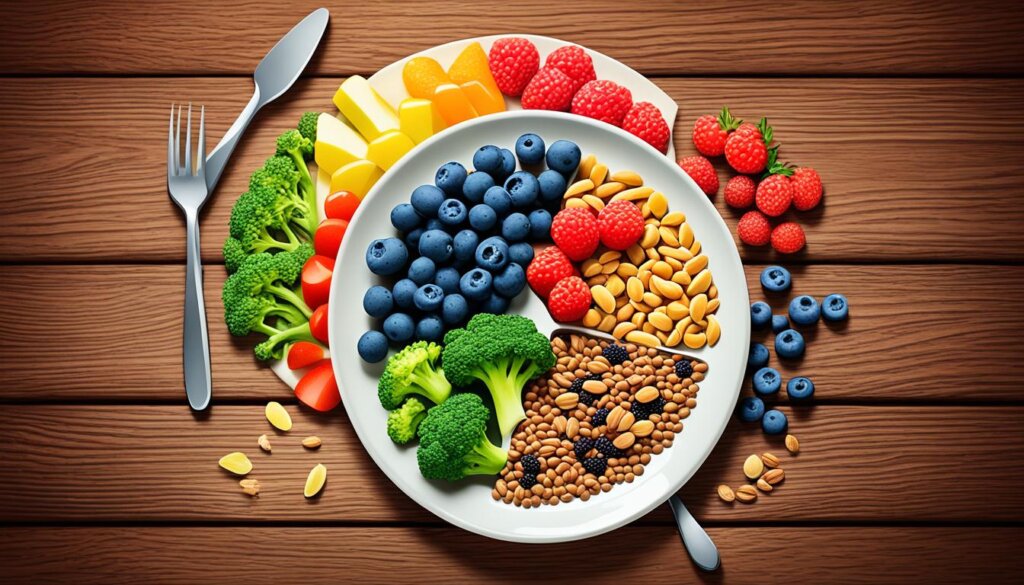
Fiber Recommendation | Women | Men |
|---|---|---|
50 years and younger | 25 grams | 38 grams |
51 years and older | 21 grams | 30 grams |
Fiber needs differ by age and gender, as shown. Eating a variety of fibrous foods helps you hit your daily goals and enjoy the full benefits of a fiber-rich life.
High Fiber Foods: Boost Your Digestive Health
Eating high-fiber foods is key for your gut and well-being. Foods high in fiber, like whole grains, fruits, veggies, and nuts, improve digestion. They make bowel movements easier, stool softer, and keep your gut healthy. Including a variety of these foods in your meals helps your gut in many ways.
Some fibers, such as in oats and fruits, help your bowels and lower cholesterol. Others, like in whole-wheat and veggies, add bulk to stool for easy passing. Eating both types is best for your gut health.
- A half-cup serving of shelled edamame has 9 grams of fiber.
- Broccoli has 5 grams of fiber per cup.
- One cup of blueberries has nearly 4 grams of fiber.
- Avocados offer 10 grams of fiber in a cup.
- One cup of popcorn gives you 1 gram of fiber.
- Apples have about 4 grams of fiber, depending on size.
- One small potato with skin has almost 3 grams of fiber.
- Sunflower seeds and almonds each have over 3 grams of fiber in a serving.
The FDA advises women under 50 to get 25 grams of fiber daily, and men, 38 grams. If you’re over 51, the amounts are slightly less. Also, slowly increasing your fiber intake is better than sudden changes. This helps your body get used to it.
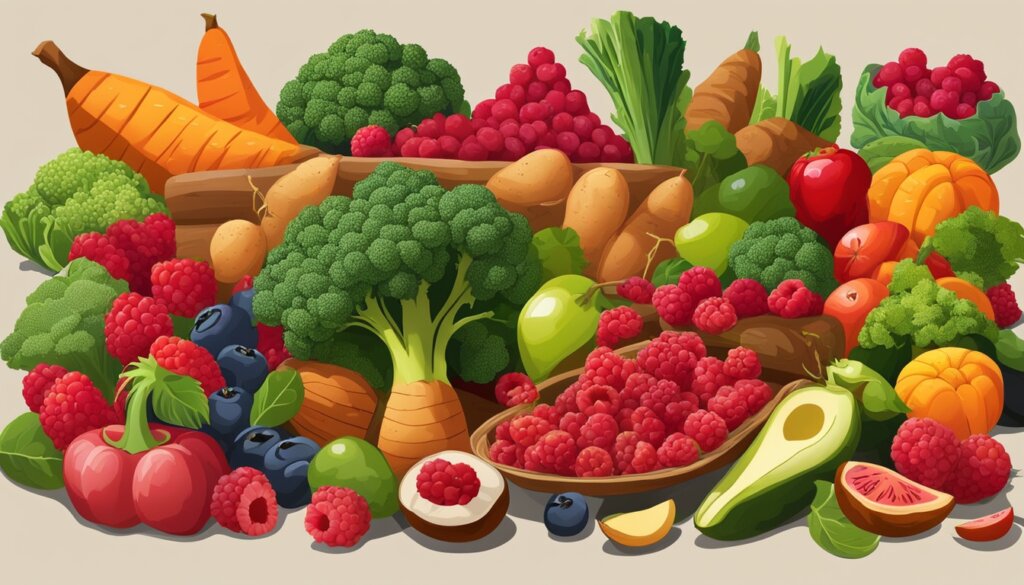
Adding various high-fiber foods to your meals and snacks helps your digestion. Try eating more whole grains, fruits, and veggies, and add nuts and seeds too. These choices are tasty and rich in fiber. They’re a great way to keep your gut healthy and happy.
Daily Fiber Recommendations
Having a high-fiber diet is key to good health. The Institute of Medicine sets daily fiber needs by age and gender. Women under 50 should have 25 grams a day, and over 50 should get 21 grams. The numbers for men are 38 grams if under 50, and 30 grams if over.
The Academy of Nutrition and Dietetics advises to aim for 14 grams of fiber per 1,000 calories. For most people, not including those with special needs, about 30 grams daily is good.
Fiber helps our digestion, heart, and blood sugar. Soluble fiber makes a healthy gut, and insoluble fiber helps with cholesterol and makes us feel full. To avoid tummy troubles, slowly add more fiber to what you eat and drink plenty of water.
Age and Gender | Recommended Daily Fiber Intake |
|---|---|
Women aged 50 or younger | 25 grams |
Women aged 51 or older | 21 grams |
Men aged 50 or younger | 38 grams |
Men aged 51 or older | 30 grams |
To get more fiber, try these foods: Artichokes have 10g in a cup. Lentils offer 8g in a half cup. Canned pumpkin has 7g per cup. Raspberries give 8g in a cup. Chia seeds offer 10g in an ounce. Popcorn has 5g in 3 cups. Almonds have 4g in a single ounce. Also, fresh fruit like raspberries makes a good fiber source.

Adding many fiber foods to your meals daily is a smart move. It helps you reach the daily fiber target and boosts health. Remember to add more fiber slowly and drink lots of water to avoid discomfort.
Best Sources of Fiber
Whole grains, fruits, and veggies are great for getting more fiber. Foods like brown rice, whole-wheat bread, and oats give you 5-7g of fiber. Fruits such as pears and berries offer 5-8g of fiber per serving. Vegetables like broccoli offer even more, giving you 5-14g per serving.
But, processed foods have less fiber. Canned fruits and veg, juices without pulp, and white breads have less fiber because their outside layers are removed. Eating whole foods is better for fiber and brings many vitamins and minerals your body needs.
Whole Grains, Fruits and Vegetables
Choosing whole grains is key. Quinoa, barley, and whole-wheat pasta are good picks, giving 5-7g of fiber. Pears, apples, and berries also boast a good amount, with 5-8g per serving. Don’t forget the veggies. Options like broccoli and artichokes can give you 5-14g of fiber.
Food | Fiber Content |
|---|---|
Lentils (1 cup boiled) | 18g |
Split peas (1 cup boiled) | 16g |
Black beans (1 cup canned) | 15g |
Pinto beans (1 cup boiled) | 15g |
Artichoke hearts (1 cup cooked) | 14g |
Kidney beans (1 cup cooked) | 12g |
Chickpeas (1 cup cooked) | 12g |
Chia seeds (2 tablespoons) | 10g |
Raspberries (1 cup) | 8g |
Blackberries (1 cup) | 7.5g |
Whole-wheat pasta (1 cup cooked) | 7g |
Barley (1 cup cooked) | 6g |
Pears (1 medium) | 6g |
Almonds (23 almonds) | 6g |
Oats (1 cup cooked) | 5g |
Broccoli (1 cup chopped) | 5g |
Quinoa (1 cup cooked) | 5g |
These foods offer a lot of fiber. They help you get a variety of nutrients and support gut health.
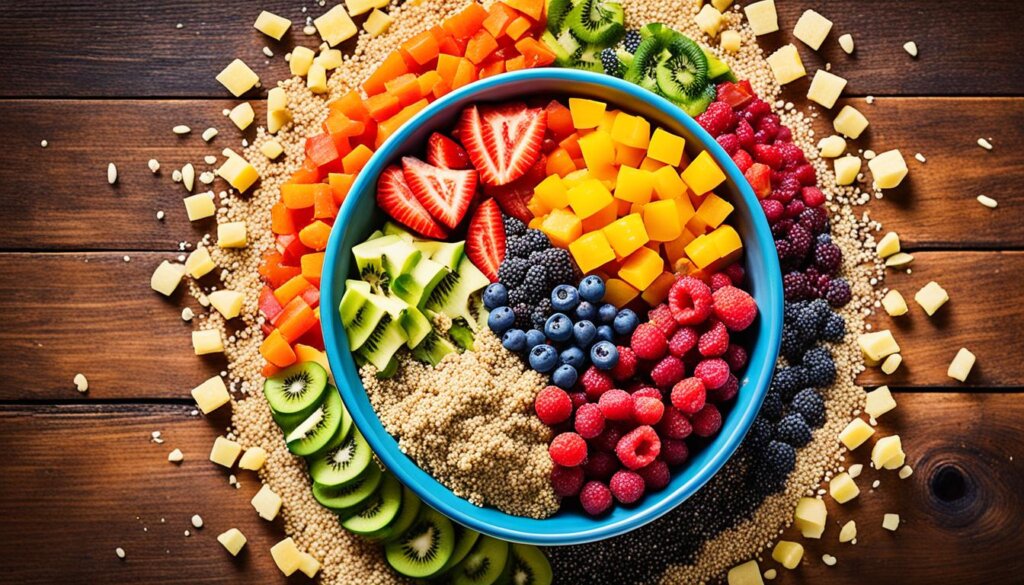
Fiber Supplements and Fortified Foods
Whole foods are the best for daily fiber. But, some might need supplements or fiber-fortified foods. Only about 5% of folks in the U.S. get enough fiber each day. The USDA says we should aim for 14 grams per 1,000 calories consumed. So, for a 2,000 calorie diet, that’s 28 grams of fiber. Sadly, few people hit that mark.
Fiber supplements come in handy. They help those who don’t get enough fiber from food alone. This is especially true for people with belly issues like constipation, diarrhea, or IBS. For some, these supplements are good for a short fix of symptoms. But remember, real foods are the best place to get fiber. They bring extra health perks, not just fiber.
One more way to get more fiber is by eating foods with extra fiber added. Think of cereals, granola bars, yogurt, and yes, even ice cream. These items often add ingredients like inulin or chicory root. These are types of soluble fiber. While these foods can up your fiber fun, some might feel gassy. It’s smart to start slowly and add more over time. This gives your body a chance to get used to it.
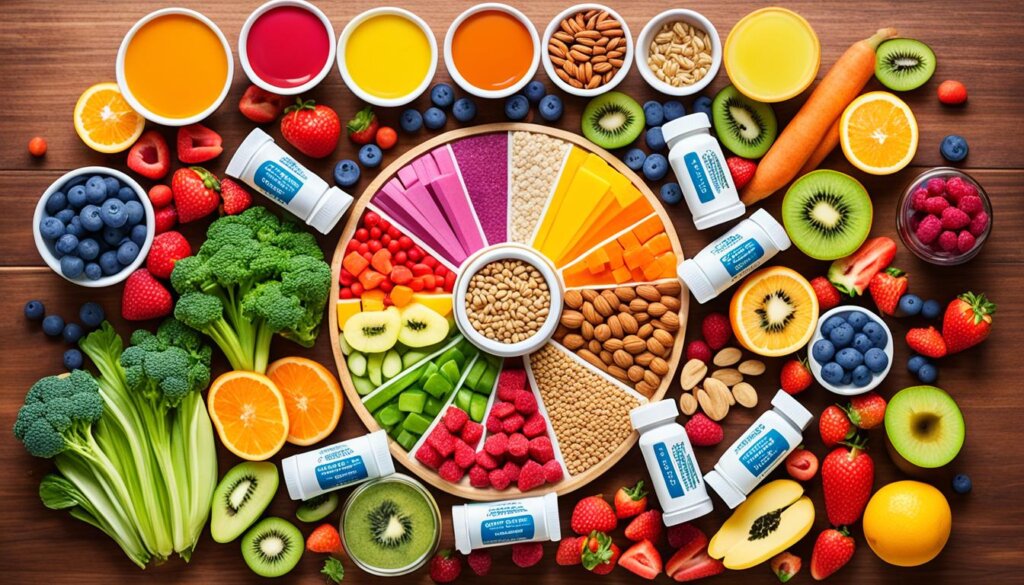
Eating plenty of fiber from real foods is the top choice for staying healthy. A high-fiber diet lowers the risk of many illnesses. This includes heart disease, diabetes, and some cancers. You can add fiber with supplements or fiber-rich foods. But, do it slowly to keep away any tummy troubles.
Tips for Adding More Fiber
Breakfast, Baking and Snacks
Adding fiber to your diet is easy and enjoyable. Begin your morning with a cereal that has 5 grams of fiber per serving. When you bake, use whole-grain flour instead of white flour to add fiber to your treats. For snacks, choose fresh fruits, veggies, whole-grain crackers, and popcorn. Also, include nuts, seeds, and legumes like beans in your snack choices.
Make your meals richer in fiber by including beans, peas, and lentils in salads or soups. Eating a vegetable soup or salad before your meal can increase your veggie intake by 23%. Popcorn makes a great snack with its 4 grams of fiber per ounce. You can also add chia seeds for a boost; they have 10 grams of fiber per ounce, mostly insoluble.
Both fruits and veggies are amazing fiber sources. An avocado half gives you 5 grams of fiber. Almonds, too, offer nearly 4 grams per ounce. Coconut flour stands out with 10 grams of fiber per ounce. For a fruit snack, choose raspberries or blackberries, as they provide 8 grams of fiber per cup.
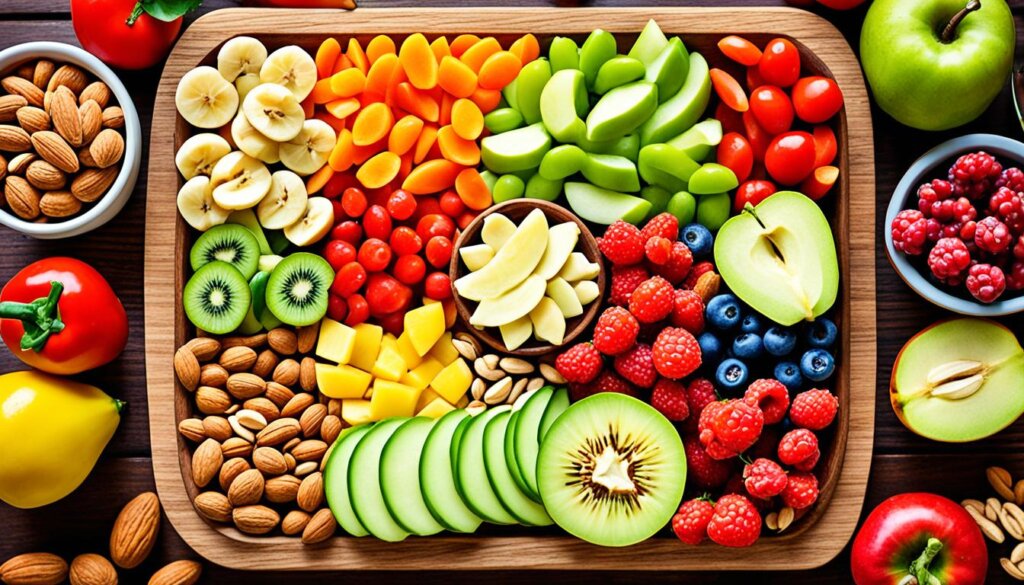
By swapping and adding foods, you can easily get more fiber. Doing so lets you enjoy a high-fiber diet and its many health benefits.
Fiber-Rich Food List
Adding high-fiber foods in your meals is good for you. It helps your stomach work well, keeps your heart strong, and might help with not gaining too much weight. You can find fiber in:
- Pears – 5.5 grams of fiber per medium pear
- Strawberries – 3 grams of fiber per 1 cup
- Avocado – 10 grams of fiber per medium avocado
- Oats – 4 grams of fiber per 1/2 cup of cooked oats
- Apples – 4.4 grams of fiber per medium apple
- Raspberries – 8 grams of fiber per 1 cup
- Bananas – 3.1 grams of fiber per medium banana
Not just fruit, veggies are great for fiber too. Try these:
- Carrots – 3.08 grams of fiber per 1 cup
- Broccoli – 5.14 grams of fiber per 1 cup
- Beets – 2 grams of fiber per two beets
- Cauliflower – 2.86 grams of fiber per 1 cup
- Artichokes – 9.58 grams of fiber per 1 cup
- Brussels sprouts – 4.06 grams of fiber per 1 cup
Also, legumes, nuts, and seeds are big on fiber. Here are some examples:
- Lentils – 15.6 grams of fiber per 1 cup
- Chickpeas – 16.2 grams of fiber per 1 cup
- Almonds – 4 grams of fiber per 1 ounce
- Chia seeds – 10 grams of fiber per 2 tablespoons
- Walnuts – 2 grams of fiber per 1 ounce
- Pumpkin seeds – 5 grams of fiber per 1 ounce
Include these foods in your meals to meet the daily fiber needs. It’s 25-38 grams, depending on how old you are and if you’re a boy or a girl. A diet rich in fiber helps your stomach and heart stay healthy.
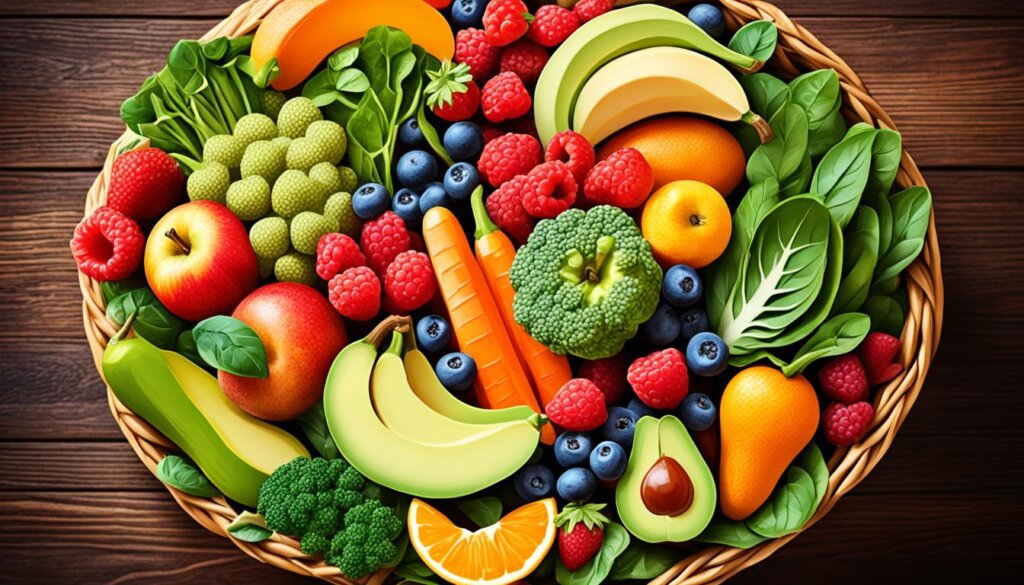
Start slowly with more fiber. This gives your body time to get used to it. Drinking water is also key for a successful high-fiber diet.
Beans and Legumes: Powerhouses of Fiber
Beans, lentils, and peas are packed with fiber. They’re great for a high-fiber diet. There are over 16,000 types of these foods. They vary in size, shape, color, and texture. People worldwide grow them.
Lentils, Kidney Beans, Edamame
Lentils, kidney beans, and edamame are high in fiber. A half-cup of edamame has 9 grams of fiber. They also have plant-based protein. Cooked lentils have 7.8 grams of fiber in a half-cup. Kidney beans offer 6.8 grams of fiber in the same amount.
Legume | Fiber Content (per 1/2 cup cooked) |
|---|---|
Edamame | 9 grams |
Lentils | 7.8 grams |
Kidney Beans | 6.8 grams |
Eating more beans and lentils boosts your fiber intake. They offer many health benefits. A cup of cooked black beans has 15 grams of fiber. That’s over half of the fiber adults need daily. Legumes help you feel full, as they are low in calories and rich in fiber and protein.
“Legumes are low-fat, cholesterol-free, and contain important nutrients like lysine, polyphenols, and resistant starch.”
It’s easy to add dried, canned, or frozen legumes to meals. They fit well in soups, salads, and many dishes. With their high fiber and nutrients, beans and lentils should be part of any healthy diet.
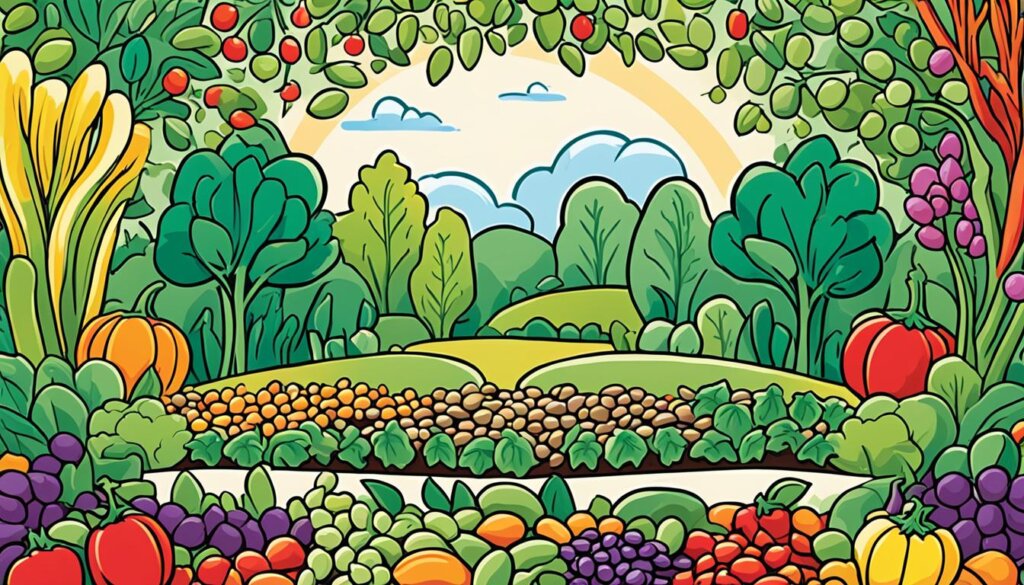
But, some might have gas or tummy trouble after eating these foods. This happens because of compounds like galacto-oligosaccharides (GOS). Soaking and rinsing dried beans reduces this effect. Despite this, the benefits of legumes are much greater than the minor issues.
Vegetables High in Fiber
Vegetables are a top source of fiber. They bring lots of nutrients for good health. For example, broccoli, cauliflower, and Brussels sprouts are full of fiber. They help your gut stay healthy.
Broccoli, Cauliflower, and Brussels Sprouts
Broccoli is packed with fiber, offering 5.14 grams in a cooked cup. It gives you 18.4% of your needed fiber for the day. Cauliflower has 2.86 grams of fiber in a cooked cup. This is 10.21% of what you should have each day. Brussels sprouts stand out with 6 grams of fiber in a cooked cup, meaning 21.43% of daily fiber needs.
These vegetables are great for your gut. They also offer many other health benefits. Broccoli is full of vitamins and antioxidants. Cauliflower and Brussels sprouts help fight inflammation.
Unfortunately, many adults in the US don’t eat enough veggies. Only about 10% get the recommended amount each day. Adding more of these fiber-filled veggies to your meals is a smart move. It makes it easier to get the fiber your body needs and keeps your gut healthy.
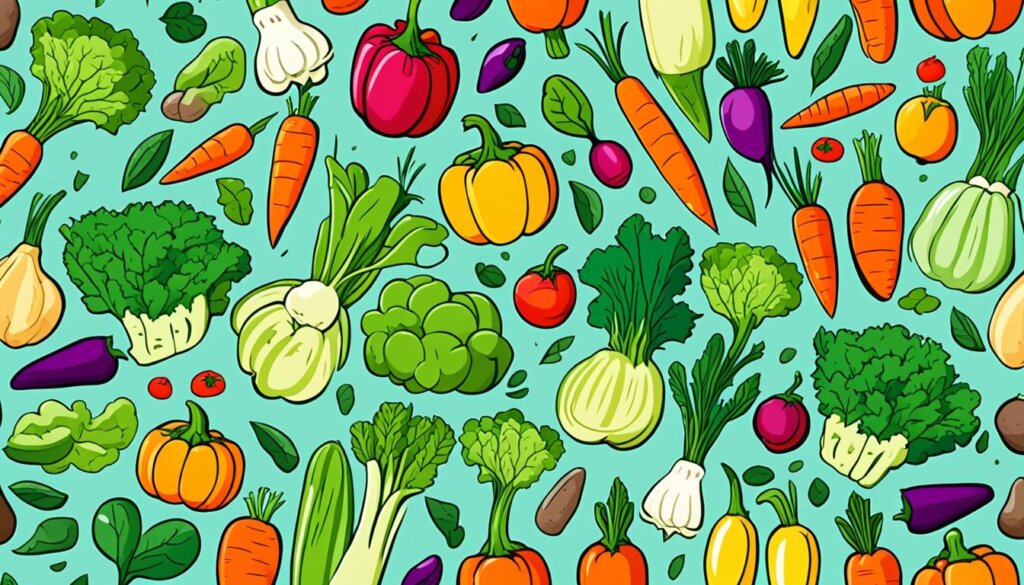
Beyond broccoli, cauliflower, and Brussels sprouts, many other veggies are great for your gut. Kale is one. It has 4.72 grams of fiber in a cooked cup, meeting 16.86% of your daily need. Artichokes are also an excellent choice, offering 6.84 grams of fiber in one cooked 4.2-ounce serving. This provides over 24% of your daily fiber.
By mixing these fiber-rich veggies into your meals, you support a healthy digestive system. This way, you can reach your daily fiber goal. Remember, adults should aim for at least 28 grams of fiber each day, as stated by the 2020-2025 Dietary Guidelines for Americans.
Vegetable | Fiber Content | Percentage of Daily Fiber Intake |
|---|---|---|
Broccoli (1 cup cooked) | 5.14 grams | 18.4% |
Cauliflower (1 cup cooked) | 2.86 grams | 10.21% |
Brussels Sprouts (1 cup cooked) | 6 grams | 21.43% |
Kale (1 cup cooked) | 4.72 grams | 16.86% |
Artichoke (1 medium, cooked) | 6.84 grams | 24.43% |
“Incorporating more high-fiber vegetables into your diet is a simple and effective way to support a healthy gut and meet your daily fiber needs.”
Focusing on fiber-rich veggies can do wonders for your health. Start adding a variety to your diet. This way, you can enjoy all the benefits they offer for your health and happiness.
Fruits Packed with Fiber
Adding high-fiber fruits to your diet is great for more fiber and a healthy gut. Berries like blueberries, blackberries, and raspberries are full of it. A cup of blueberries gives you nearly 4 grams. Apples, pears, and avocados are also rich in fiber. They fit well into a balanced diet. Adults need from 22 to 34 grams of fiber each day, based on their age.
Each cup of raspberries and blackberries has around 8 grams of fiber. For every cup, blueberries have almost 4 grams, and strawberries offer 3 grams. Pomegranate arils have 7 grams in a cup. Passion fruit is high too, with 25 grams per cup. Guava provides 9 grams, kiwi has 5 grams, and mango 3 grams per cup. A medium pear gives close to 6 grams. A medium apple is about 4 grams. Plus, half an avocado has nearly 7 grams.
Most adults should aim for 25 to 30 grams of fiber daily, but many don’t get enough. Eating more high-fiber fruits is an easy, tasty way to boost fiber and help your digestion.
Fruit | Fiber Content |
|---|---|
Raspberries | 8 grams per cup |
Blackberries | 8 grams per cup |
Blueberries | 4 grams per cup |
Strawberries | 3 grams per cup |
Pomegranate arils | 7 grams per cup |
Passion fruit | 25 grams per cup |
Guava | 9 grams per cup |
Kiwi | 5 grams per cup |
Mango | 3 grams per cup |
Pear | 6 grams per medium fruit |
Apple | 4 grams per medium fruit |
Avocado | 7 grams per half fruit |
Eating a mix of high-fiber fruits is tasty and healthy. Berries, pears in baking, or avocado toast are good choices. They help reach your daily fiber target and keep your gut working well.
Whole Grains for Fiber Intake
Whole grains like oats, brown rice, and whole wheat have a lot of fiber. They also have vitamins, minerals, and plant compounds for your health.
Check food labels to make sure you’re really getting whole grains. Look for “whole grain” or “whole wheat” as the first ingredient. This step is key because processed grains lose fiber.
Oats, Brown Rice, Whole Wheat
Oats help lower cholesterol and keep blood sugar stable. Brown rice has more fiber and protein than white rice. Whole wheat can be used in many foods, adding fiber and nutrients.
Eating a mix of whole grains helps you get enough fiber. Aim for 25 to 35 grams of fiber a day for good health. Women need over 20 grams, and men need over 30 grams, says Harvard.
Whole grains offer protection against some cancers and heart disease. They help with constipation, diverticulosis, and blood sugar in diabetics. Look for the “whole grain stamp” to make sure you’re choosing whole grain products.
“Whole grains are rich in fiber, Vitamin E, B Complex Vitamins, selenium, potassium, and magnesium.”
Eating various whole grains is an easy way to increase your fiber. It can help your digestion and metabolism.
Nuts and Seeds for Extra Fiber
Nuts and seeds give you great fiber and healthy fats. They also have many good nutrients. Try almonds, sunflower seeds, chia seeds, and walnuts for high fiber. A small amount can really boost your fiber.
Nuts and seeds are full of fiber. One ounce can give you 5 to 35% of what you need each day. People should get up to 38 grams of fiber daily, but most don’t get enough, studies show.
Looking for nuts and seeds that are high in fiber? Chia seeds, flax seeds, pumpkin seeds, and more make the list. Tuck them into your snacks, meals, or baking for a fiber punch.
Nut or Seed | Fiber Content (per 1 oz. serving) |
|---|---|
Chia Seeds | 10g |
Flax Seeds | 5.6g |
Pumpkin Seeds | 5g |
Sesame Seeds | 4g |
Sunflower Seeds | 3.2g |
Hazelnuts | 2.7g |
Almonds | 3g, 3.5g |
Pistachios | 3g, 3g |
Pecans | 3g |
Pine Nuts | 3g, 3g |
Macadamia Nuts | 2.5g |
Walnuts | 2g, 2g |
Many nuts and seeds do more than give fiber. Almonds, walnuts, and pistachios can help lower bad cholesterol. Eating 1-2 ounces each day is a smart choice to get the most from these foods.
Remember to mix high-fiber nuts and seeds into your meals and snacks. They’re not just good for you, they’re tasty and easy to enjoy every day. With their great taste and crunch, it’s easy to get your needed fiber.
Slowly Increase Fiber for Gut Health
When you add more fiber to your diet, go slow. Don’t do it all at once. Eating too much fiber fast can lead to stomach troubles like gas and bloating.
To sidestep these problems, add fiber little by little. This lets your body get used to it. You’ll get all the good from fiber without the icky feelings.
Adding fiber is great for your gut and overall health. But, take it easy at first. Add two to three more grams to your daily intake to ease into it. This way, you’ll have less gas and bloating. Also, drink more water. It helps fiber move through your body, preventing bloating and constipation.
Moving more when you eat more fiber is smart. It keeps unwanted side effects away and boosts the good parts of a fiber-rich diet. But, remember, balance is key. Slowly up the fiber to feel your best.
Adding a mix of fiber foods to your meals is the way to go. Choose from whole grains, fruits, veggies, beans, and nuts. They give your body the nutrients it needs and meet your daily fiber goals.
“Eating a variety of fiber-rich foods is crucial for maintaining gut health and overall well-being.”
To make a high-fiber diet work, increase it little by little and drink up. With time and steady effort, you’ll enjoy better gut health and a happier body.
Conclusion
Adding high-fiber foods to your diet is great for your gut and overall health. Start by eating a little more fiber each day. We need different amounts of fiber based on our age and gender. Getting enough fiber makes your digestion better and helps keep a healthy gut. Plus, it might lower your chances of getting diseases like diabetes, heart disease, and stroke.
Eat foods that are full of fiber as part of your daily routine. Follow the 2020-2025 Dietary Guidelines for lots of healthy fiber options. You can choose from high-fiber cereals to artichokes and beans. Including these foods in your meals helps your digestive and gut health.
Fiber supplements have their place, but it’s better to get fiber from natural foods. Adding more fiber to what you eat and drinking enough water is key. This way, you’ll see the many benefits of a diet rich in fiber. It helps with digesting food well and lowers the risk of certain diseases.
FAQ
What is dietary fiber?
What are the different types of fiber?
What are the benefits of a high-fiber diet?
What are some good sources of dietary fiber?
How much fiber do I need per day?
Can I get fiber from supplements and fortified foods?
How can I increase my fiber intake?
What are some examples of high-fiber foods?
How do beans and legumes provide fiber?
What are some high-fiber vegetables?
What are some high-fiber fruits?
What are the best whole grains for fiber?
How can nuts and seeds boost my fiber intake?
Should I increase my fiber intake gradually?
Source Links
- https://www.helpguide.org/articles/healthy-eating/high-fiber-foods.htm
- https://www.eatingwell.com/article/283531/top-fiber-rich-foods-for-good-gut-bacteria/
- https://www.mayoclinic.org/healthy-lifestyle/nutrition-and-healthy-eating/in-depth/fiber/art-20043983
- https://www.healthline.com/nutrition/22-high-fiber-foods
- https://www.houstonmethodist.org/blog/articles/2022/sep/7-benefits-of-fiber-that-should-convince-you-to-eat-enough-of-it/
- https://www.eatingwell.com/article/287742/10-amazing-health-benefits-of-eating-more-fiber/
- https://www.benefiber.com/fiber-in-your-life/daily-fiber-intake/top-10-high-fiber-foods/
- https://www.realsimple.com/how-much-fiber-do-you-need-a-day-7564730
- https://www.ucsfhealth.org/education/increasing-fiber-intake
- https://health.clevelandclinic.org/high-fiber-foods
- https://www.dietaryguidelines.gov/resources/2020-2025-dietary-guidelines-online-materials/food-sources-select-nutrients/food-0
- https://www.medicalnewstoday.com/articles/323133
- https://www.healthline.com/nutrition/high-fiber-foods-chart
- https://www.optum.com/en/health-articles/article/healthy-living/10-high-fiber-foods-you-should-eat-every-week/
- https://www.forbes.com/health/nutrition/best-fiber-snacks/
- https://www.healthline.com/nutrition/16-ways-to-eat-more-fiber
- https://zoe.com/learn/vegetables-high-in-fiber
- https://www.todaysdietitian.com/newarchives/063008p28.shtml
- https://medlineplus.gov/ency/patientinstructions/000193.htm
- https://www.webmd.com/food-recipes/health-benefits-legumes
- https://medlineplus.gov/ency/patientinstructions/000726.htm
- https://www.health.com/high-fiber-vegetables-7499209
- https://www.eatingwell.com/article/8044305/best-high-fiber-vegetables/
- https://www.mayoclinic.org/healthy-lifestyle/nutrition-and-healthy-eating/in-depth/high-fiber-foods/art-20050948
- https://www.eatingwell.com/best-high-fiber-fruits-8639024
- https://www.realsimple.com/health/nutrition-diet/high-fiber-fruits
- https://www.today.com/health/diet-fitness/high-fiber-fruits-rcna155690
- https://www.johnmuirhealth.com/health-education/health-wellness/nutrition-diet/whole-grains-fiber.html
- https://www.eatingwell.com/article/8031247/healthy-whole-grains-to-eat-more-fiber/
- https://www.myfooddata.com/articles/nuts-seeds-high-in-fiber.php
- https://www.thedietchefs.com/high-fiber-nuts-and-seeds/
- https://thenutmarket.com.au/blogs/health-benefits/high-fibre-nuts
- https://www.healthyforlifemeals.com/blog/how-to-increase-fiber-intake-without-side-effects
- https://www.healthline.com/health/food-nutrition/fiber-diet-good-for-gut-and-health
- https://www.healthline.com/nutrition/foods-high-in-soluble-fiber
- https://www.ncbi.nlm.nih.gov/books/NBK559033/
- https://www.medicalnewstoday.com/articles/fiber-diet
